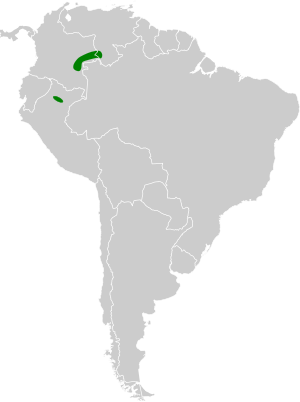Barred tinamou facts for kids
Quick facts for kids Barred tinamou |
|
|---|---|
| Conservation status | |
| Scientific classification | |
| Genus: |
Crypturellus
|
| Species: |
casiquiare
|
 |
|
The barred tinamou (Crypturellus casiquiare) is a special type of bird. It lives in the warm, wet forests of northern South America. This bird is known for its unique look and how it cares for its young.
Contents
About the Barred Tinamou
The barred tinamou is a monotypic species. This means it is the only bird in its group, without any other close relatives that are considered different species.
All tinamous belong to the Tinamidae family. They are also part of a larger group of birds called ratites. You might know other ratites like ostriches or emus. Most ratites cannot fly, but tinamous are different! They can fly, even though they are not very strong flyers. Scientists believe tinamous are the closest living relatives to ancient flying birds.
What's in a Name?
The scientific name for the barred tinamou is Crypturellus casiquiare. The first part, Crypturellus, comes from old Latin and Greek words.
- kruptos means covered or hidden.
- oura means tail.
- ellus means small or tiny.
So, Crypturellus means "small hidden tail." This name fits because the barred tinamou's tail is quite small and often hard to see.
What Does It Look Like?
The barred tinamou is about 25 cm (9.8 in) long. That's about the size of a small ruler!
- Its back has a yellowish-buff color with strong black stripes.
- Its throat is white.
- The front and sides of its neck and chest are light gray.
- Its belly is white.
- Its sides are creamy with black stripes.
- Its head and neck are a reddish-brown color.
- Its legs are olive-green.
Female barred tinamous usually have a slightly lighter color on their backs than the males.
How It Behaves
Like other tinamous, the barred tinamou mostly eats fruit. It finds fruit on the ground or on low bushes. It also enjoys eating small invertebrates (like insects), flower buds, soft leaves, seeds, and roots.
When it comes to raising a family, the male barred tinamou does most of the work! He sits on the eggs, which can come from up to four different females. After the eggs hatch, he takes care of the young birds until they are ready to live on their own. This usually takes about two to three weeks. The nest is built on the ground, often hidden in thick bushes or between the large roots of trees.
Where It Lives
The barred tinamou likes to live in warm, wet lowland forests. It prefers areas that are not too high up, usually between 100 to 200 m (330–660 ft) above sea level. You can find this bird in eastern Colombia and southern Venezuela.
Its Conservation Status
The IUCN (International Union for Conservation of Nature) keeps track of how many animals are left in the wild. They have listed the barred tinamou as "Least Concern." This means that there are still many of these birds, and they are not currently in danger of disappearing. Their home range covers a large area of about 49,000 km2 (19,000 sq mi).
See also
 In Spanish: Tinamú casiquiare para niños
In Spanish: Tinamú casiquiare para niños


